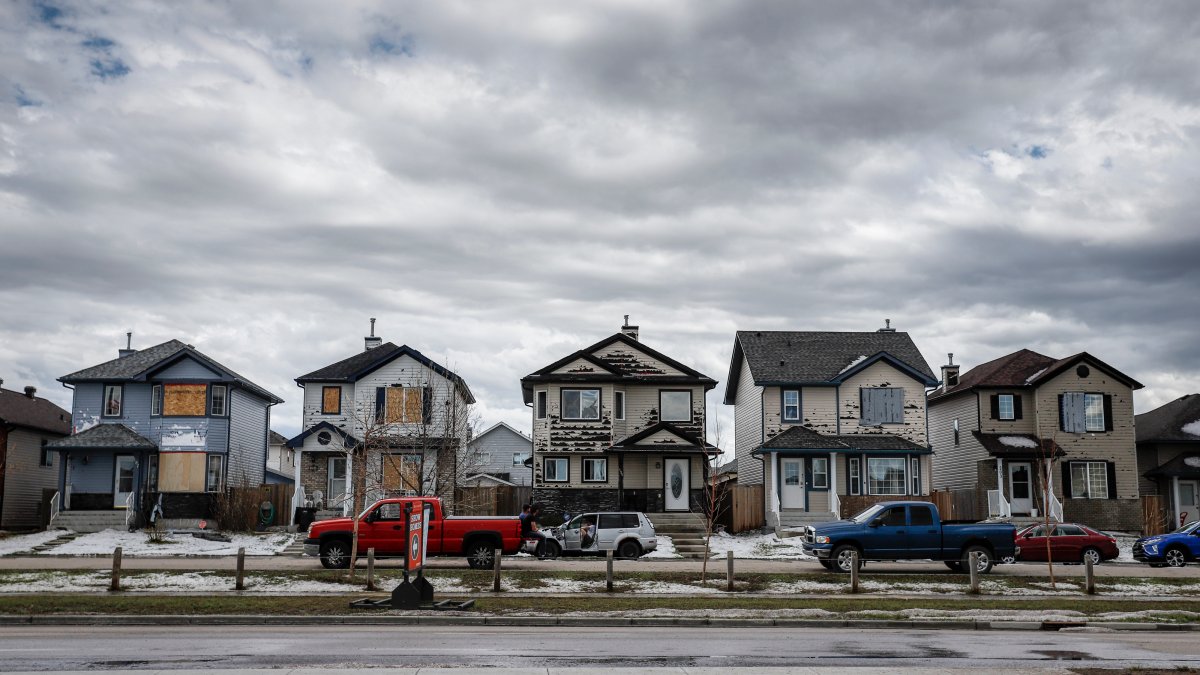Editor’s note: A previous version of this story said the benefit-cost ratio for less hail-prone areas increases. This story has been corrected to say that ratio increases for more hail-prone areas. We regret the error.

Calgary homeowners looking to get some help installing a hail-resistant roof may be out of luck.
In June 2021, the City of Calgary opened applications for the resilient roofing rebate program, allowing homeowners who met eligibility criteria like installing impact-resistant roofing, using a contractor who is a member of a roofing association and being caught up on their property taxes.
That program is now oversubscribed.
“We’ve had overwhelming response to this program,” Kris Dietrich, coordinator of customer solutions with the City of Calgary, told Global News.
“It’s been incredibly successful and not only in the education component, but in the incentive and application component.”
The city has received 2,472 applications between June 1, 2021, and March 29, 2022. City council approved $5.25 million for the program and at $3,000 per rebate that means about 1,600 households will be able to get funds.
The city had to start a waitlist in mid-February.
“The applications had come in — and so quickly — that we realized that we were probably oversubscribed, so we started moving people to a waitlist,” Dietrich said. “I encourage (homeowners) to still apply.”
The roofing rebate, spearheaded by then-councillor George Chahal, was originally a response to the June 2020 hailstorm causing more than $1 billion in insured damages. That hail event hit the city’s northeast the hardest and the program was opened for that quadrant.
On Jan. 1, the city opened up the rebate program to homes across the city.
On April 19, city officials like Dietrich will be going back to council’s executive committee with an update on the rollout of the rebate. Dietrich said city officials are still working on recommendations for the committee to consider, recommendations that could include increasing funding to the program.
Benefits outweigh costs

Get breaking National news
A recent study from the Institute for Catastrophic Loss Reduction (ICLR) shows the benefits of installing resilient roofing in an area prone to hail outweigh the costs, lauding the Calgary rebate.
For an impact-resistant roof in Calgary, the additional $3,400 in cost would yield a $10,000 benefit, resulting in a benefit-cost ratio of 3:1. In other more hail-prone areas, that ratio improves to 8:1.
“The shingles are cost effective wherever it hails almost once a year or more,” the report reads.
Large areas of southern Alberta, southern Saskatchewan, and parts of Manitoba and British Columbia were highlighted as seeing measurable benefits to hail-resistant roofing.
Calgary is just one community that sits in Alberta’s “hail alley” with hail season running from June to September.
According to the Insurance Bureau of Canada, the June 2020 hail event resulted in $1.2 billion in damage and a hailstorm just 13 months later caused another $247 million in damages.
The paper authored by ICLR chief engineer Keith Porter looked at the types of asphalt shingles, how their impact resistance is measured, where in Canada hail is most-frequent, the cost to replace them following a hail storm, and the price for Class 1 to Class 4 and unclassified shingles.
Porter said impact-resistant shingles look nearly the same as plain shingles.
“But they have a special material that resists damage and they reduce hail losses by a factor of about 30, 15 times lower chance of significant damage and two times lower cost when you do have damage,” Porter told Global News.
A roof covered in hail-resistant materials is much less likely to require replacement compared to one that isn’t following a hailstorm, where the long-term cost savings come from.
“We found that we could have avoided much of the loss in Calgary had the building code required impact-resistant shingles there in the first place.”
The report said houses can see benefit even if they don’t use Class 4 shingles, like required for the Calgary rebate.
And it said financial incentives like a government grants or loans, regulatory advantages, or reduced insurance premiums can reduce barriers.
Porter said insurance companies see the benefit in lower policy payouts, but balked at having to shoulder the upfront costs. Another ICLR report showed a long-term benefit for insurance companies to help upgrade roofing.
“We found that if the insurance company decided to go above and beyond and put in that extra $3400, they would save something over $4000 in the long run on the average policy.”
And the benefits aren’t just limited to homeowners or insurance companies, he said.
“At the societal level, a more resilient building stock means society pays less to own its buildings,” Porter said. “Impact-resistant roofs cost society less. They mean that our buildings cost less to own in the long run.”

A changing climate will make matters worse, the ICLR chief engineer said.
“Climate change is going to create more severe hailstorms and cause more harm to more people. It will expand the area where impact resistant shingles are cost effective and it will make the benefit-cost ratio in a lot of places go up.”
And re-shingling a roof contributes to climate change via emissions, Porter added.
“Every time you have to tear up a roof and replace it, there’s energy to do that, and there’s energy put into the new asphalt shingle roof, so, in a small way, you’re making the problem worse.”










Comments